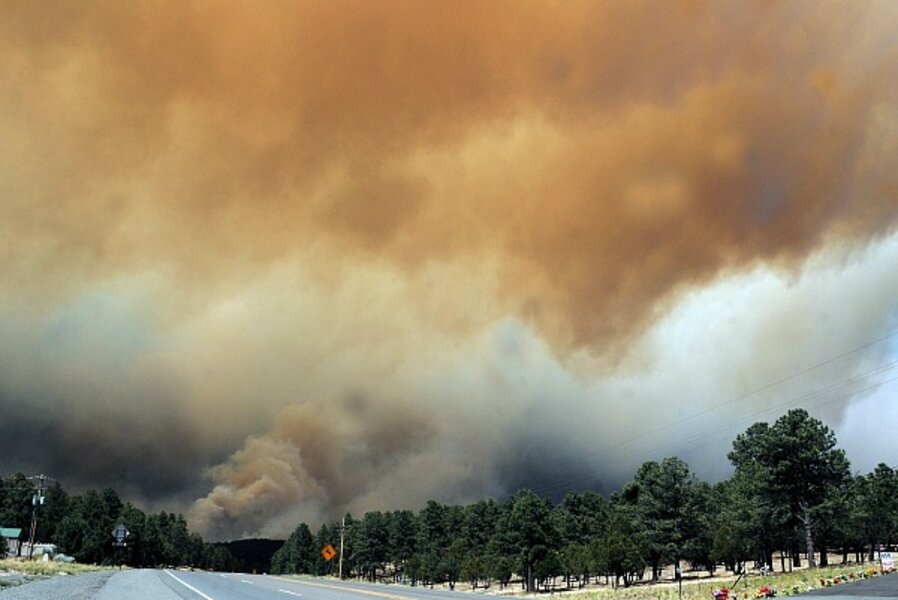Western wildfires forcing evacuations in Colorado, New Mexico
Loading...
| ALBUQUERQUE, N.M.
Firefighters in Colorado and New Mexico are battling wind-fueled wildfires that are moving fast through parched forests, forcing scores of evacuations and destroying or damaging numerous structures.
A blaze in northern Colorado was first reported Saturday morning and had grown to about 8,000 acres by mid-evening, while a fire in southern New Mexico was small for a few days until it began growing Friday, reaching about 10,000 acres.
Both fires have damaged property and forced numerous evacuations, but officials haven't yet released specific figures on the numbers who fled.
The wildfire in the mountainous Paradise Park area, about 20 miles northwest of Fort Collins, prompted several dozen evacuation orders.
Larimer County Sheriff's Office spokesman John Schulz said the fire expanded rapidly during the late afternoon and evening and by Saturday night, residents living along several roads in the region had been ordered to evacuate and many more were warned that they might have to flee. An evacuation center has been set up at a Laporte middle school.
Officials didn't specify how many residents had evacuated but said they had sent out 800 emergency notifications urging people to be prepared to evacuate if necessary.
Law officers went door to door to alert people in the evacuation area, but officials were worried that not everyone got the word.
"Right now we're just trying to get these evacuations done and get people safe," Schulz told Denver-based KMGH-TV, adding that "given the extreme heat in the area, it makes it a difficult time for (the firefighters)."
Ten structures have been damaged, although authorities were unsure if they were homes or some other kind of buildings. No injuries have been reported. The cause of the fire was unknown.
Aerial footage from KMGH-TV showed flames coming dangerously close to what appeared to be several outbuildings and at least one home in the area, as well as consuming trees and sending a large plume of smoke into the air.
The Federal Emergency Management Agency said it was authorizing federal funds to help pay for firefighting efforts.
Two heavy air tankers, five single-engine air tankers and four helicopters were on the scene to help fight the blaze, which appeared to be burning on private and U.S. Forest Service land and was being fueled by sustained winds of between 20 and 25 mph.
"It was just good conditions to grow," National Weather Service meteorologist Chad Gimmestad told The Associated Press. "The conditions today were really favorable for it to take off."
Wind was also playing a major role in the expansion of a lightning-sparked blaze in New Mexico's Lincoln National Forest that jumped its containment lines and raced through thick conifer forests. Fire managers said 20 structures were damaged or destroyed.
Spanning only a few acres on Wednesday, the Little Bear fire began to grow Friday and by Saturday afternoon about 10,000 acres had been charred northwest of the mountain community of Ruidoso.
"It's nerve-racking right now," Mayor Ray Alborn said in a telephone interview Saturday, as he watched what he described as "real heavy smoke" rise from the Sierra Blanca mountain range.
The mix of timber, dry grass and the steepness of the slopes were making the firefighting efforts more difficult. Windy conditions were also limiting what could be done from the air by helicopters and air tankers, Alborn said.
"Today all we see is smoke," he said. "Last night, we saw the flames too and it was an awesome expression of power. It was red, red and we could see it going across the top."
Fire information officers said summer homes in a few subdivisions and several campgrounds were evacuated late Friday, and more on homes on Saturday. Roads throughout the area were closed, said forest spokeswoman Peg Crim.
The fire was burning in steep, rocky, inaccessible terrain in the White Mountain Wilderness of the Lincoln National Forest, which is home to Smokey Bear, the little black cub that became the nation's symbol of fire prevention in the 1940s.
U.S. Rep. Steve Pearce, R-N.M., was on his way to the area Saturday to meet with fire managers. He said decades of mismanagement, forests packed full of trees and persistent drought conditions have resulted in an explosive situation.
"We just can't keep managing our forests this way. It's not a question of if our forests in the West are going to burn, it's a matter of when. This is just one more demonstration of that," he said.





